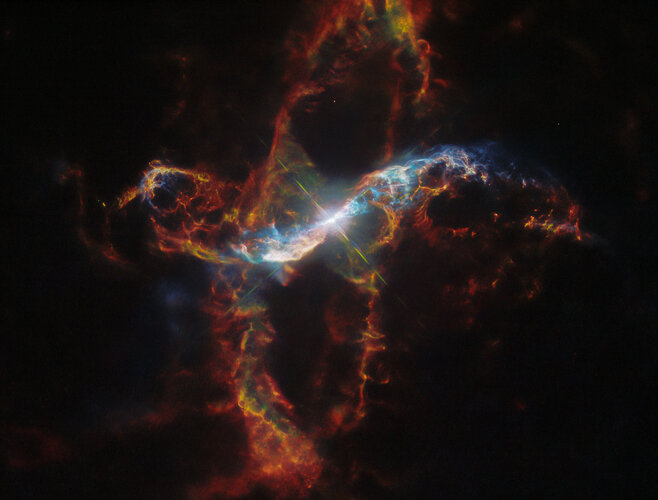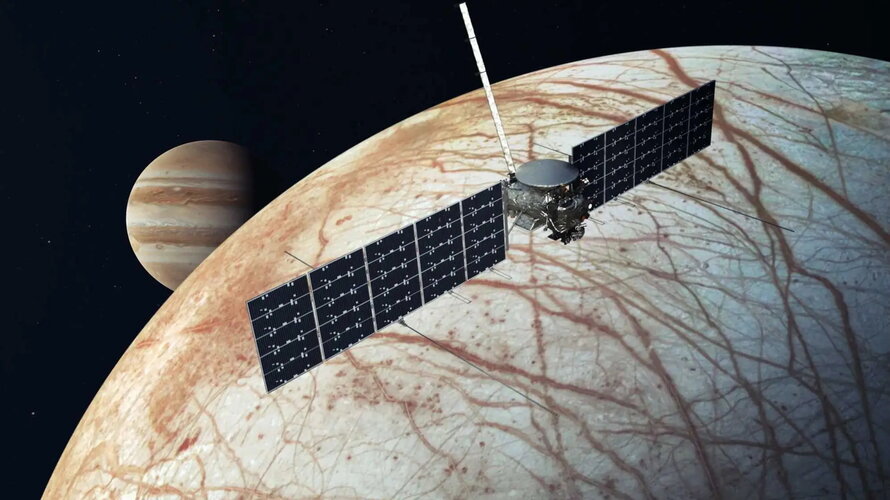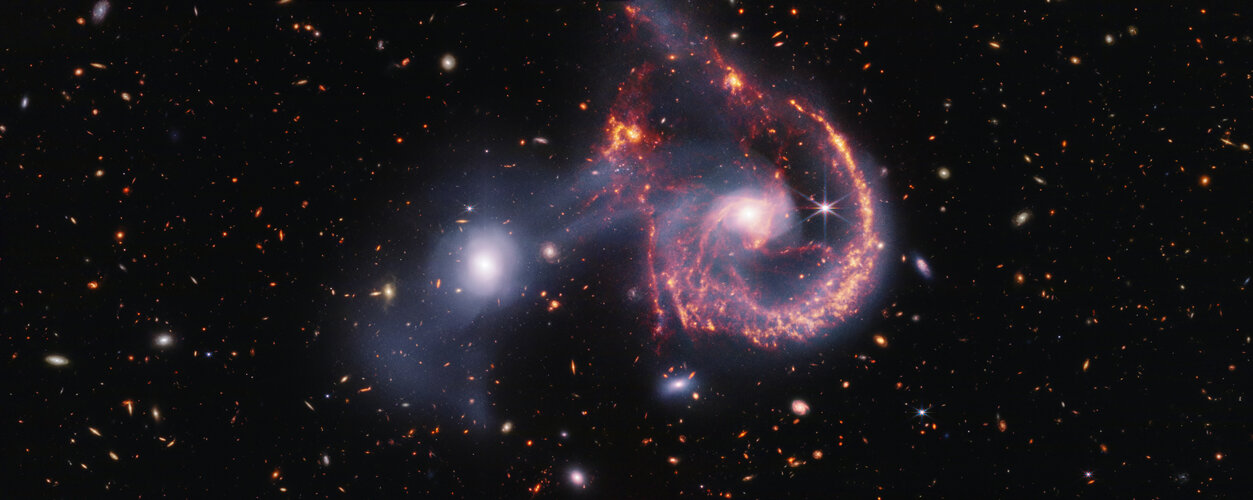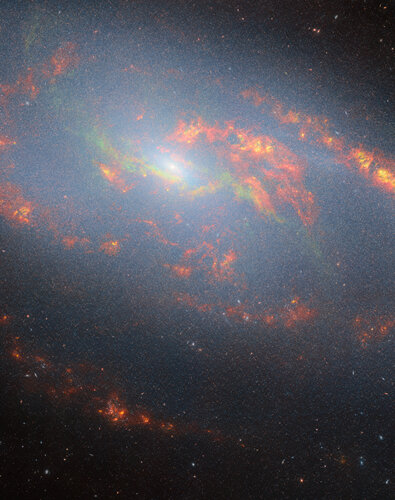
The NASA/ESA Hubble Space Telescope has provided a dramatic and colourful close-up look at one of the most boisterous stars in our galaxy, weaving a huge spiral pattern among the stars. Hubble's images capturing its details and its evolution are featured by a unique timelapse video.

On 15 October 2024, ESA’s Euclid space mission revealed the first piece of its great map of the Universe, showing millions of stars and galaxies.
 Video:
00:00:23
Video:
00:00:23
From 7 until 13 October 2024, ESA/NASA’s SOHO spacecraft recorded Comet C/2023 A3 (Tsuchinshan–ATLAS), the second brightest comet it has ever seen. Meanwhile, large amounts of material were being spewed out by the Sun (covered in the centre), and planet Mercury is visible to the left.
The comet’s nucleus is clearly visible, surrounded by a dusty coma and trailing an impressively long tail. SOHO sees the large dust tail edge-on, curving in on itself as it is pushed outward by solar wind.
At the end of the video you can also see a rare phenomenon known as an ‘anti-tail’: a long, thin line that points towards the Sun. This tail is an optical illusion coming from SOHO getting an edge-on view of the larger cometary dust particles that accumulate in the comet’s orbital plane.
Comet C/2023 A3 was seen for the first time early last year. It most likely came from the distant Oort cloud.
The comet reached an estimated peak brightness just beyond –4 magnitude. (The more negative the visual magnitude value, the brighter the object.) Of the more than 5000 comets SOHO has seen flying past the Sun, only Comet C/2006 P1 (McNaught) was brighter, with a visual magnitude of –5.5.
SOHO’s location between the Sun and Earth gave it a front-row seat, but the same comet has been visible from Earth every evening since 12 October 2024. Throughout October, as the comet moves farther away from the Sun, it will gradually grow fainter and rise higher up in the western sky.
The week that SOHO watched Comet Tsuchinshan–ATLAS was also a wild one in terms of space weather. The Sun unleashed no less than 4 X-class flares (the highest intensity type of flare), 28 medium-intensity M-class flares, and 31 coronal mass ejections – the latter being visible as white clouds of material in the video. All this activity led to two geomagnetic storms on Earth, resulting in beautiful auroras lighting up the night sky.
SOHO, short for Solar and Heliospheric Observatory, is a joint ESA-NASA mission to study the Sun. For almost 29 years now, it has been watching the Sun itself as well as the much fainter light coming from the Sun’s outer atmosphere, called the solar corona. The data shown in this video were taken by the LASCO C3 coronagraph instrument.
Special thanks to Simeon Schmauß, who processed the raw data to create this impressive video. For comparison, here is a video of the comet with more standard data processing – the comet is so bright that it partially saturated SOHO’s sensor.
What types of comets are there?

What’s better than one spacecraft on the quest to search for life-friendly ocean worlds in the Jupiter system? Two! ESA’s Jupiter Icy Moons Explorer (Juice) is set to join forces with NASA’s Europa Clipper – launched on 14 October – to tackle one of the biggest questions in Solar System science.

ESA’s Mars Express has captured an astonishing array of landforms emerging from a thick winter blanket of frost as spring arrives in the south polar region of Mars. Some of these features are surprisingly dark compared with their icy surroundings, earning their nickname of ‘cryptic terrain’.

As BepiColombo sped past Mercury during its June 2023 flyby, it encountered a variety of features in the tiny planet’s magnetic field. These measurements provide a tantalising taste of the mysteries that the mission is set to investigate when it arrives in orbit around the Solar System’s innermost planet.
 Image:
Webb’s new view of Arp 107
Image:
Webb’s new view of Arp 107
 Video:
00:01:15
Video:
00:01:15
See Mercury in a whole new light, through the ‘eyes’ of the ESA/JAXA BepiColombo spacecraft, as it sped past Mercury during its latest encounter on 4 September 2024.
During the flyby, BepiColombo’s three monitoring cameras (M-CAMs) captured detailed images of the planet’s cratered surface. Within these images, Mercury scientists identified various geological features that BepiColombo will study in more detail once in orbit around the planet.
One such feature, shown in this video, is the newly named Stoddart crater. The name ‘Stoddart’ – after artist Margaret Olrog Stoddart (1865–1934) – was recently assigned following a request from the M-CAM team, who realised that this crater would be visible in these images and decided it would be worth naming considering its potential interest for scientists in the future.
Stoddart is a special type of crater called a ‘peak ring basin’. These mysterious craters are created by powerful asteroid or comet impacts, and are named after the inner ring of peaks on an otherwise flattish floor.
The video then pans around to the larger Raphael crater. Many newer craters dot the surface and walls of Raphel, giving an indication of Mercury’s violent history.
At the end of the video the camera zooms out to put the region into perspective.
The 3D scene was reconstructed from a single image using the ‘Shape from Shading’ method. Shape from Shading uses a reflectance model to render an artificial image of the surface from an initial 3D model. This render is compared to the original image, and the 3D model is subsequently improved to minimise the difference between the images. The heights in the video are not to scale. The flyover was created in Unity.
The 4 September gravity assist flyby was the fourth at Mercury and the seventh of nine planetary flybys overall. During its eight-year cruise to the smallest and innermost planet of the Solar System, BepiColombo makes one flyby at Earth, two at Venus and six at Mercury, to help steer itself on course for entering orbit around Mercury in 2026.
BepiColombo is an international collaboration between ESA and JAXA.
BepiColombo’s best images yet highlight fourth Mercury flyby
BepiColombo images in ESA’s Planetary Science Archive
 Video:
00:01:25
Video:
00:01:25
Watch the closest flyby of a planet ever, as the ESA/JAXA BepiColombo spacecraft sped past Mercury during its latest encounter on 4 September 2024.
This flyby marked BepiColombo’s closest approach to Mercury yet, and for the first time, the spacecraft had a clear view of Mercury’s south pole.
This timelapse is made up of 128 different images captured by all three of BepiColombo’s monitoring cameras, M-CAM 1, 2 and 3. We see the planet move in and out of the fields of view of M-CAM 2 and 3, before M-CAM 1 sees the planet receding into the distance at the end of the video.
The first few images are taken in the days and weeks before the flyby. Mercury first appears in an image taken at 23:50 CEST (21:50 UTC) on 4 September, at a distance of 191 km. Closest approach was at 23:48 CEST at a distance of 165 km.
The sequence ends around 24 hours later, on 5 September 2024, when BepiColombo was about 243 000 km from Mercury.
During the flyby it was possible to identify various geological features that BepiColombo will study in more detail once in orbit around the planet. Four minutes after closest approach, a large ‘peak ring basin’ called Vivaldi came into view.
This crater was named after the famous Italian composer Antonio Vivaldi (1678–1741). The flyover of Vivaldi crater was the inspiration for using Antonio Vivaldi’s ‘Four Seasons’ as the soundtrack for this timelapse.
Peak ring basins are mysterious craters created by powerful asteroid or comet impacts, so-called because of the inner ring of peaks on an otherwise flattish floor.
A couple of minutes later, another peak ring basin came into view: newly named Stoddart. The name was recently assigned following a request from the M-CAM team, who realised that this crater would be visible in these images and decided it would be worth naming considering its potential interest for scientists in the future.
BepiColombo’s three monitoring cameras provided 1024 x 1024 pixel snapshots. Their main purpose is to monitor the spacecraft’s various booms and antennas, hence why we see parts of the spacecraft in the foreground. The photos that they capture of Mercury during the flybys are a bonus.
The 4 September gravity assist flyby was the fourth at Mercury and the seventh of nine planetary flybys overall. During its eight-year cruise to the smallest and innermost planet of the Solar System, BepiColombo makes one flyby at Earth, two at Venus and six at Mercury, to help steer itself on course for entering orbit around Mercury in 2026.
BepiColombo is an international collaboration between ESA and JAXA.
BepiColombo’s best images yet highlight fourth Mercury flyby
BepiColombo images in ESA’s Planetary Science Archive
Processing notes: The BepiColombo monitoring cameras provide black-and-white, 1024 x 1024 pixel images. These raw images have been processed to remove electronic banding in the cameras. The M-CAM 1 images have been cropped to 995 x 995 pixels
 Image:
Digel Cloud 2S
Image:
Digel Cloud 2S
 Video:
00:04:11
Video:
00:04:11
ESA's Euclid mission is surveying the sky to explore the composition and evolution of the dark Universe. But how can Euclid see the invisible? Watch this video to learn about the light-bending effect that enables scientists to trace how dark matter is distributed in the Universe.
By making use of Euclid’s flagship simulation, the video illustrates how dark-matter filaments subtly alter the shape of galaxies. Light travelling to us from vastly distant galaxies is bent and distorted by concentrations of matter along its way. The effect is called gravitational lensing because matter (both ‘normal’ and dark matter) acts as a kind of magnifying glass.
Scientists distinguish between strong and weak gravitational lensing. In strong gravitational lensing distortions of background galaxies or other light sources are very apparent, resulting in arcs, multiple images or so-called Einstein rings. In weak lensing, background sources appear only mildly stretched or displaced. This means we can only detect this effect by analysing large numbers of sources in a statistical way.
The further we look, the more prominent the distortions from weak gravitational lensing are, because there are more dark-matter structures acting as lenses between us and the light sources.
Euclid will measure the distorted shapes of billions of galaxies over 10 billion years of cosmic history, providing a 3D view of the dark matter distribution in our Universe. This will shed light on the nature of this mysterious component.
The map of the distribution of galaxies over cosmic time will also teach us about dark energy, which affects how quickly the Universe expands. By charting the Universe’s large-scale structure in unprecedented detail, Euclid will enable scientists to trace how the expansion has changed over time.
 Video:
00:06:50
Video:
00:06:50
The first of four satellites that make up ESA’s Cluster mission is coming safely back down to Earth, marking a brilliant end to this remarkable mission.
The satellite’s orbit was tweaked back in January to target a region as far as possible from populated regions. This ensures that any spacecraft parts that survive the reentry will fall over open ocean.
During 24 years in space, Cluster has sent back precious data on how the Sun interacts with Earth’s magnetic field, helping us better understand and forecast potentially dangerous space weather.
With this first ever targeted reentry, Cluster goes down in history for a different reason, taking ESA well beyond international space safety standards and helping ensure the long-term sustainability of space activities.
 Image:
Image:
During its recent flyby of Earth, ESA's Jupiter Icy Moons Explorer (Juice) travelled through the zones of charged particles that surround our planet. These two zones are known as the Van Allen radiation belts. The inner belt is mostly full of energetic protons, and the outer belt is mostly full of energetic electrons. The region between the two belts is mostly empty.
The high levels of radiation in the Van Allen belts makes them very dangerous for electronics and humans, but they pale in comparison to Jupiter's own radiation belts. At Jupiter, extremely energetic electrons can get through even the thickest of shielding, so they could damage Juice's scientific instruments over time.
Juice carries a radiation monitor called RADEM to continuously measure the spacecraft's exposure to high-energy particles. RADEM forms part of a long-term plan to better understand radiation throughout the Solar System, and supplements Juice's Plasma Environment Package – a collection of sensors designed to measure charged particles around Jupiter and its icy moons.
Juice's flight through the Van Allen belts was RADEM's first big test in space. It passed with flying colours, successfully measuring electrons in the outer belt, then protons in the inner belt, then electrons again as it moved away from Earth. The blue and yellow dots indicate the intensity of electrons and protons that Juice measured; in both cases the intensity peaks as Juice goes through the densest part of the belt.
These observations demonstrated the capabilities of RADEM and provided a great opportunity to cross-calibrate the instrument with other spacecraft orbiting Earth in a well-known environment.
More about Juice's lunar-Earth flyby
More about Juice's instruments
RADEM was built in Portugal by Efacec in collaboration with the Laboratory for Instrumentation and Experimental Particle Physics, the Paul Scherrer Institute and Integrated Detector Electronics.
[Image description: Black background with planet Earth at the centre. We see a spacecraft travelling around Earth from right to left. Concentric white circles surround Earth, indicating distance. It is possible to move a slider to switch between two images that both have all of the aforementioned elements. The left image shows a ring of white closely surrounding Earth; blue dots (protons) are plotted along Juice's trajectory, peaking where Juice travels through this white band. The right image shows a ring of white further from Earth; yellow dots (electrons) are plotted along Juice's trajectory, peaking in the two places where Juice travels through this white band.]
 Image:
Webb peeks into Perseus
Image:
Webb peeks into Perseus
 Image:
The hidden intricacies of Messier 106
Image:
The hidden intricacies of Messier 106